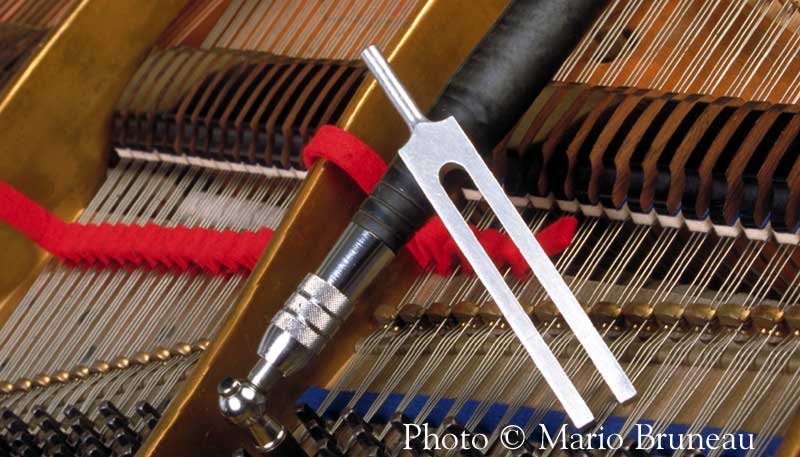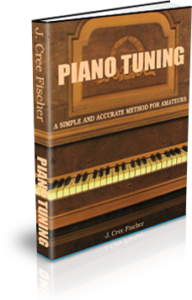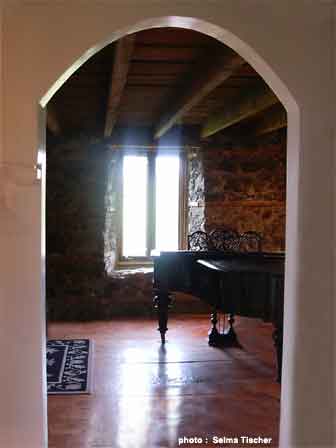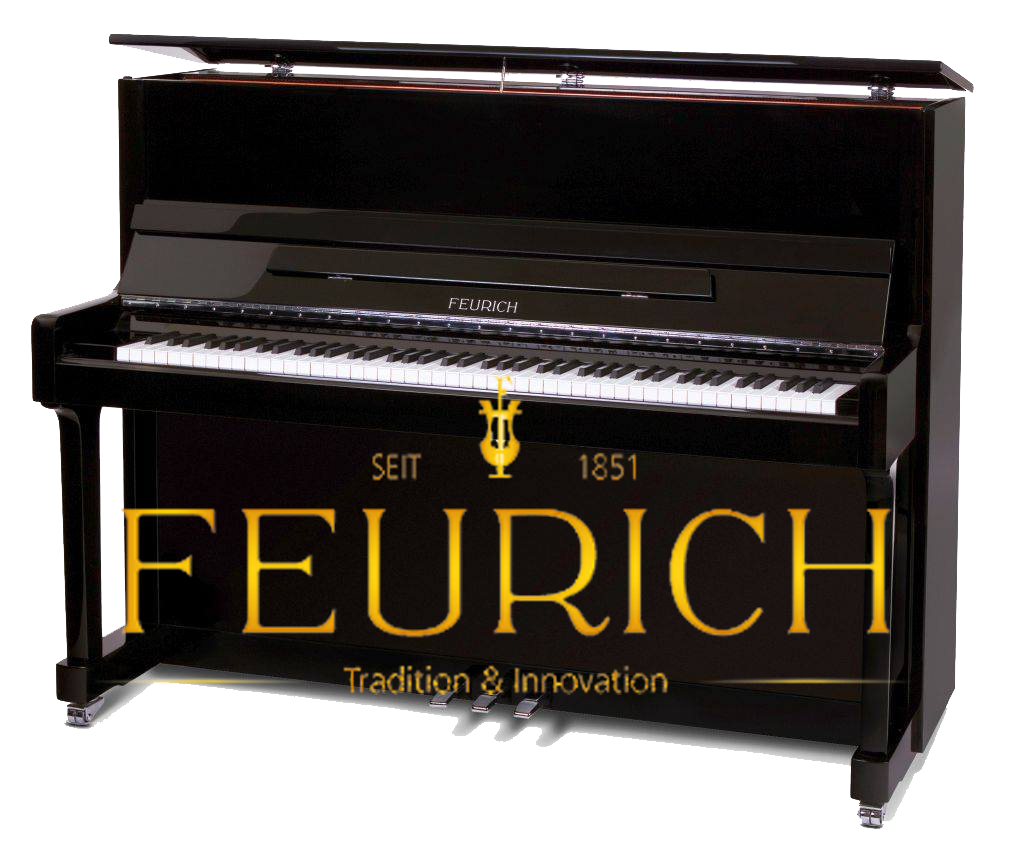Promote harmony in the universe...
have your piano tuned!

Don't have your piano tuned because it is out of tune,
have it tune to keep it tuned!
Please also visit my piano site at https://pianos-en.mariobruneau.com/
During my 50 years career as piano tuner-tech, I had the opportunity to write articles in different magazines and newspapers. You will find them here mixed with news and thoughts.
PIANO INTRODUCTION
The piano is considered the king of all musical instruments. Invented in 1709 by the Italian Bartolomeo Cristofori (1655-1731), it was the first keyboard instrument that was able to produce dynamics that is, to play soft and loud hence its name pianoforte (piano = soft, forte = loud)
Cristofori's pianoforte was a rather delicate instrument but since then and with numerous improvements, it has become the rich and powerful piano we know today. Improvements to its action from the single escapement to double escapement, the increased tension of the strings with the addition of the cast iron plate, the crossing of the bass strings running over the treble strings to permit a longer string length without adding to the total dimension are few examples of its evolution.
ts construction's complexity, the science involved in its design and the delicate balance between forces contributing to its sonority has always intimidate pianists. Although respected by the pianists, the piano remains the instrument least known of his interpreters hence the many myths surrounding its construction.
The consumer searching for a piano have no other choices but to trust the "seller" as the opinion of a pianist and/or teacher is necessarily subjective. The pianist friend is still very useful to judge the sound of an instrument when you can't play it yourself.
After the house and car, the piano is the third major acquisition incurred by a family. It is therefore important to chose it well. It will then become an investment. Due to its longevity, the piano is a family heritage bequeathed from generation to generation. Your grand children's own children will still benefit from its musicality. The whole family can always count on this generous musical instrument to enliven the holidays, special occasions or to brighten the day.
Contrary to instruments where the musician must first learn to produce an adequate sound before interpreting a piece of music, the piano sounds great no matter what notes are chosen since it is the technician-tuner's job the make it sound right. So your children's contact and learning of music is thus made easier.
Children's hearing ability is far superior to that of adults. They are very sensitive to the sound of an instrument. Offering your children a bad piano can only contribute to its discouragement and at the same time, destroy an unrevealed talent.
A good piano will always find its place in your house. Even if no one plays (yet) in the house, it will be appreciated when an uncle musician comes to visit or a friend's professional musician. Only then will you be proud of your purchase.
The piano is one of the finest family estates.
It follows your family over several generations.
Take your time to make a good choice, you will be rewarded.
Mario Bruneau
© Copyright – 1997 – All rights reserved
Piano and accordion tuning courses available
Call me at: (819) 769-1407 or contact me via email
Have you ever thought of tuning your own piano?

Before you get my complete piano tuning tutorial with eBooks and videos, you can get this "out of print" piano tuning ebook that I have modified to today's standards.
You can get it for only $7 and it will give you a good start to study piano tuning. You will soon find out how to tune your own piano with this piano tuning ebook.
I have improved the graphics with image processing software and added some of my own illustrations.
I have completely re-format this book for better legibility.
Instant download
Where I start learning my trade
I learned my trade mostly at Montreal Piano on Rachel street in Montreal.
I want to thank Mr. Louis Lovsin and his son for their patience answering my questions all those years. I invite you to visit their website and also to visit their shop at 61 Rachel Street O. in Montreal.
Article No.1
When should your piano be tuned?
A tuned piano is so much fun to play and even more to listen to.
Indeed, in their effort to design the best sounding musical instrument there is, designers base their calculations towards the fact that their musical instrument will perform at its best when tuned to the universal standard that is, the A=440Hz tuning fork.
Piano is no exception to this and was designed to give its best sound when tuned to standard. The A=440Hz tuning fork standard is the reference pitch by witch all musical instruments are tuned in order to play together in harmony.
In order for all musical instruments to play in unison and harmony, they are all tuned to the tuning fork standard of A=440Hz (Hz = Hertz, vibrations per seconds) To maintain your piano at the tuning standard and for your personal comfort, you must take care that the humidity percentage in your house is kept between 35% and 60% whenever possible.
In Eastern Canada, during the winter season, we must heat our houses which have the effect of lowering substantially the humidity level down to dangerous levels like minus 30%. When loosing its humidity, wood shrinks so the 5 centimeters thickness that the soundboard and maple bridge represent will diminish thus lowering the the string's tension. The pitch of your piano gets lowered.
On the opposite, during the summer season when the humidity level often reach the 100% in the house, the wood gets thicker and pushes the string's tension up. Your piano's pitch rises. Yes, you heard me right! At the end of the summer, your piano will be higher than it was at the beginning exactly like if a piano tuner came to raise the tension of the strings thus raising the pitch.
Because the piano looses more tension in the winter than it gains during the summer, it must be tuned at least once a year.
After two years without tuning, chances are your piano will need two tuning anyway to bring its tension back to the tuning standard. This is why in Quebec, we can't skip one year of tuning to save money because it will need two tunings next year anyway to bring it back to pitch.
Also bear in mind that "you will never waste a tuning" thinking that you may have been able to wait an other year or for whatever reason. Your piano's food is tuning. The more often you get it tuned, the better it will sound and the better will it keep its tuning so at the long run, you will appreciate playing on a piano which is always at its maximum performance. May I dare compare it to your automobile. Would you ever skip an oil change and tune-up? I guest not.
I now live in Magog near Sherbrooke in Quebec's Eastern Townships but I often go to Montreal to serve my regular clients so don't hesitate to call me even if you're in the Montreal area. Obviously, I tune everywhere in the Eastern Townships
The price for one regular tuning is $200. So, following what was stated earlier, if your piano wasn't tuned for several years, chances are it will need two tunings to bring it up to A=440 standard pitch so $200 X 2 = $400. The repairs or other mechanical adjustments are not included in the tuning prices.
Mario Bruneau
© Copyright – 1997 – All rights reserved
Article No.2
The effects of time over your piano
This article was first published in LE TOUR a Sutton-Dunham-Frelighsburg newspaper. Winter 2005
Invented by the Italian Bartoloméo Cristofori, the piano was the first keyboard musical instrument that enabled playing loud and soft hence its name pianoforte (piano = soft, forte = loud) From the rather delicate instrument it was, it evolved in the rich and loud piano of today following numerous improvements. the complexity of its construction, the science involved in its realization, the delicate balance between the forces that contribute to its sound are all very intimidating for the pianists. Although much respected, the piano is one of the least known musical instruments of its interpreters which lead to a lot of misunderstanding toward its construction.

My Blüthner circa 1893 in Dunham
It is a well known fact that a piano must be tuned at least once a year but the effect of time over your piano need further explanations that I will simplify for this article.
The metal string, sound source of the piano, doesn't move enough air molecules to be perceptible by human ear so it needs a vibrating surface to amplify it. So the string transmit its vibration to a half inch thick soundboard via a inch and a half maple bridge. With a surface area of almost 21 square foot, the soundboard is the speaker of the piano.
Each string his pulled to a 175 pounds tension and with a total of 230 strings, the piano has 20 tons of tension. Cristofori's poor pianoforte would have fold into itself. It is the cast iron plate that supports all this tension and it is precisely this tension that is altered by the time.
I order for all the musical instruments to be able to play together in an harmonious fashion, they must follow a tuning standard of A=440Hz (Hz = vibrations/second) The ideal dampness level is between 35% and 60% but our cold winters forces us to heat the inside of our house thus contribution is lowering the humidity level.
Wood shrinks when loosing its humidity, so the total of 2 inches representing the thickness of the soundboard added to the one of the bridge will diminish too so tension goes down. The piano's pitch is lowered.
At the opposite, the rise the combined thickness of the soundboard and bridge du to humidity levels of 90 to 100% found during the summer will raise the tension of the strings. The piano's pitch will go up. Because the piano's pitch will fall more every years than it goes up, the piano needs to be tuned every year.
So after more than two years without being tuned, your piano will need two tunings to bring it to standard pitch. Contrary to popular beliefs, a piano as low as a semi tone flat can be brought up to pitch with only two tunings and the 24 hours interval between them is also a myth.
We must then consider the 20 tons of tension to understand that the first string which was raised in tension will become looser as we increase the tension of other strings, since each string acts as a clamp.
So to compensate for the clamp effects, the first tuning will be somewhat higher than the A=440Hz beginning with the bass region at A=442 and then the middle region at A=443 progressing up to A=445 on the higher region. After that first tuning, the piano will be at A=440 throughout its entire range but will not be quite tuned yet. It is only on the second tuning that precision can be achieve because the overall tension of 20 tons will not be altered.
Unlike electronic gears, your piano is available anytime even during a power failure. If it is well kept and tuned regularly, nice music will always come out. So, sit down, relax and enjoy it.
Mario Bruneau, pianist – tuner-technician (819) 769-1407
Visit the official site Les Pianos Mario Bruneau
© Copyright – 1997 – Tous droits réservés





